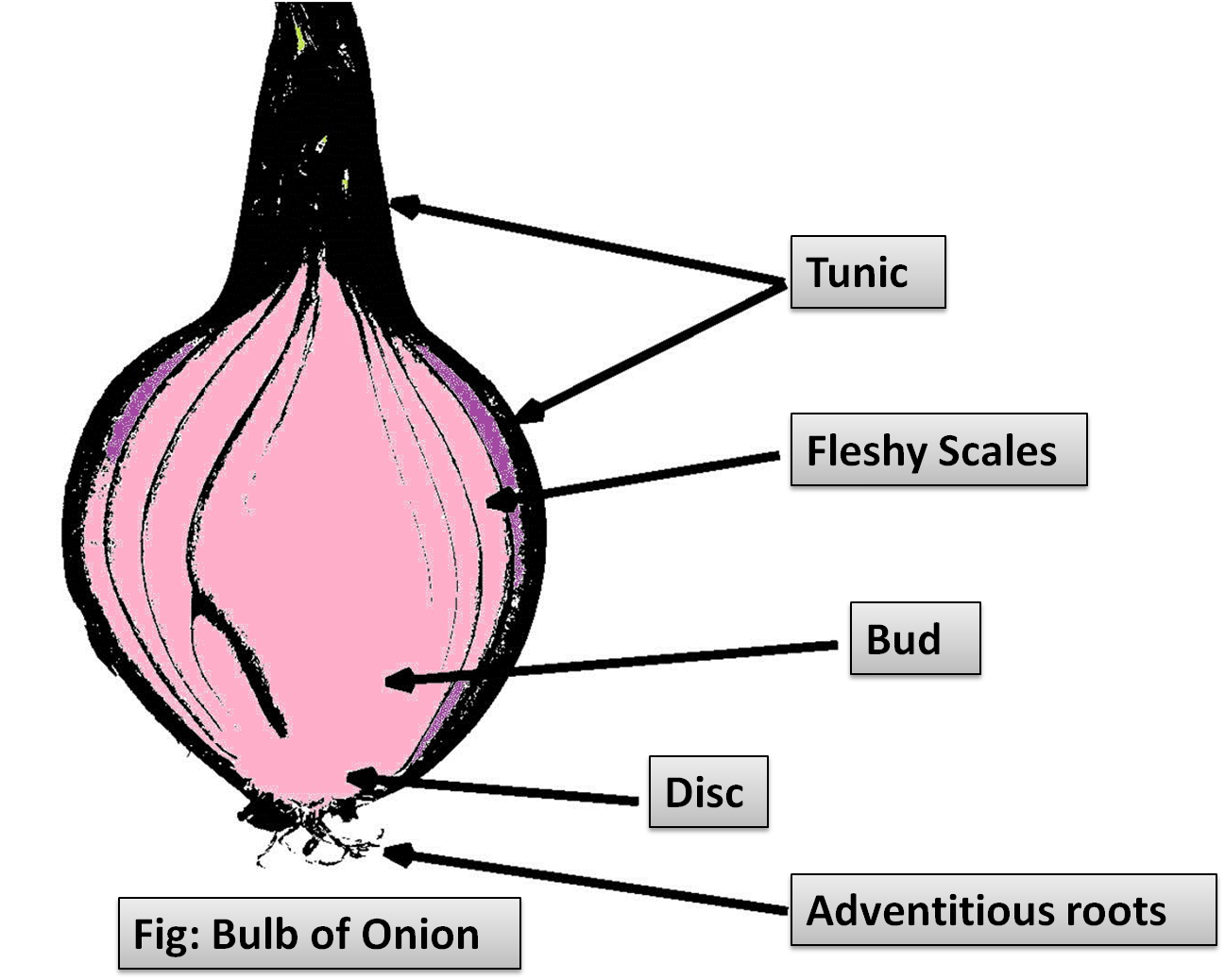
Which one of the following is correctly matched?
(a) Onion - Bulb
(b) Ginger - Sucker
(c) Chlamydomonas - Conidia
(d) Yeast - Zoospores
Answer
579.9k+ views
Hint: Various stem modifications can be observed in nature for food storage, protection or to carry out photosynthesis. The underground or subterranean stems lie beneath the surface of the soil for the motive of perennation.
Complete answer:
The bulb is a type of underground stem modification observed in Onion. It is an underground pyriform(pear-shaped) structure with a slightly conical disc-shaped stem and numerous fleshy scales enclosing a terminal bud. A number of adventitious roots arise from its base. The bulbs are non green, store food, and take part in perennation. Buds and roots occur over them which can be used as a tool of vegetative propagation.
Additional Information:
The rhizome is a perennial fleshy underground stem which is differentiated into nodes and internodes just as a usual stem. It is of two types based on its position under the soil- Rootstock, when the rhizome is upright or oblique with the tip almost reaching the soil surface as well as unbranched, and, Straggling- when the rhizome is horizontal and branched. Ginger is an example of a straggling rhizome.
Yeast is a fungus and belongs to the subclass Ascomycetes.they multiply asexually through the formation of conidia. Conidia are asexual mitospores produced exogenously on stalked structures ‘conidiophores’. Conidia are often green, pink, or blue and thus provides coloration to the fungus.
Chlamydomonas is a microscopic, eukaryotic, unicellular, pyriform, and biflagellated green algae found in both freshwater and marine water. It reproduces asexually through the formation of zoospores. These are motile spores formed in zoosporangium- a sac-like structure that bursts to release zoospores.

So, the correct answer is ‘ Onion - Bulb’.
Note:
Mitosis is a type of division where a cell is divided in such a manner that the daughter cells receive the exact number of chromosomes as the parent cell. Mitospores are formed via mitosis. E.g.Sporangiospores, Conidia. On the other hand, meiospores are formed by meiosis. It is a type of division where daughter cells receive half the number of chromosomes as their parents. They give rise to haploid individuals. E.g. Ascospores, Basidiospores.
Complete answer:
The bulb is a type of underground stem modification observed in Onion. It is an underground pyriform(pear-shaped) structure with a slightly conical disc-shaped stem and numerous fleshy scales enclosing a terminal bud. A number of adventitious roots arise from its base. The bulbs are non green, store food, and take part in perennation. Buds and roots occur over them which can be used as a tool of vegetative propagation.
Additional Information:
The rhizome is a perennial fleshy underground stem which is differentiated into nodes and internodes just as a usual stem. It is of two types based on its position under the soil- Rootstock, when the rhizome is upright or oblique with the tip almost reaching the soil surface as well as unbranched, and, Straggling- when the rhizome is horizontal and branched. Ginger is an example of a straggling rhizome.
Yeast is a fungus and belongs to the subclass Ascomycetes.they multiply asexually through the formation of conidia. Conidia are asexual mitospores produced exogenously on stalked structures ‘conidiophores’. Conidia are often green, pink, or blue and thus provides coloration to the fungus.
Chlamydomonas is a microscopic, eukaryotic, unicellular, pyriform, and biflagellated green algae found in both freshwater and marine water. It reproduces asexually through the formation of zoospores. These are motile spores formed in zoosporangium- a sac-like structure that bursts to release zoospores.

So, the correct answer is ‘ Onion - Bulb’.
Note:
Mitosis is a type of division where a cell is divided in such a manner that the daughter cells receive the exact number of chromosomes as the parent cell. Mitospores are formed via mitosis. E.g.Sporangiospores, Conidia. On the other hand, meiospores are formed by meiosis. It is a type of division where daughter cells receive half the number of chromosomes as their parents. They give rise to haploid individuals. E.g. Ascospores, Basidiospores.
Recently Updated Pages
Why are manures considered better than fertilizers class 11 biology CBSE

Find the coordinates of the midpoint of the line segment class 11 maths CBSE

Distinguish between static friction limiting friction class 11 physics CBSE

The Chairman of the constituent Assembly was A Jawaharlal class 11 social science CBSE

The first National Commission on Labour NCL submitted class 11 social science CBSE

Number of all subshell of n + l 7 is A 4 B 5 C 6 D class 11 chemistry CBSE

Trending doubts
What is meant by exothermic and endothermic reactions class 11 chemistry CBSE

10 examples of friction in our daily life

One Metric ton is equal to kg A 10000 B 1000 C 100 class 11 physics CBSE

1 Quintal is equal to a 110 kg b 10 kg c 100kg d 1000 class 11 physics CBSE

Difference Between Prokaryotic Cells and Eukaryotic Cells

What are Quantum numbers Explain the quantum number class 11 chemistry CBSE




